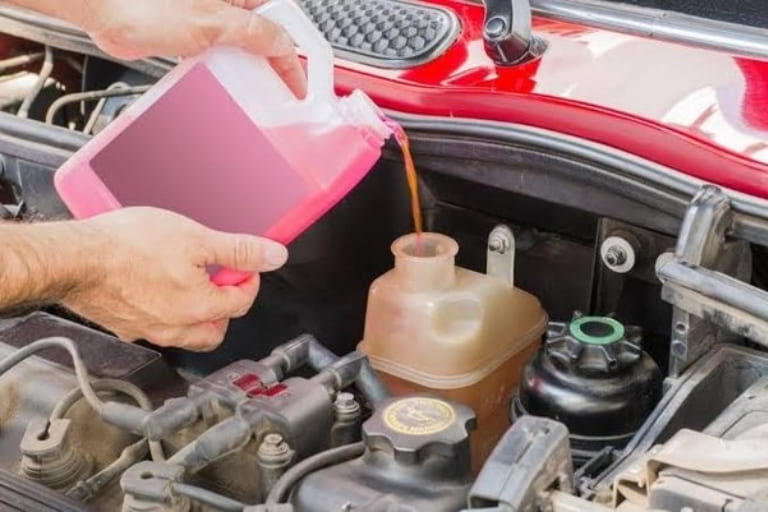Maintaining proper transmission fluid levels is crucial for adequately functioning your car’s automatic transmission. It not only lubricates the gears when switching, but it also ensures effective performance.
However, many car owners have a question: Can you add transmission fluid while the car is off?
This blog will address the question briefly and discuss the potential concerns.
We’ll also examine the advantages and potential risks of adding transmission fluid while the car’s engine runs.
Whether you’re a seasoned technician or a first-time automobile owner, this blog is for you. Let’s discover the truth about adding transmission fluid to your automobile.
Contents
Why Is It Essential to Check and Maintain Transmission Fluid Levels?
Checking and maintaining transmission fluid levels is essential to vehicle maintenance as this is critical to the correct operation of an automatic transmission.
A vehicle’s gearbox is one of its most essential components. It is in charge of transferring power from the engine to the wheels. Gearbox fluid lubricates the gears, bearings, and other system elements of an automatic transmission. It also contributes to and sustains the hydraulic pressure required for gear changing.
When the transmission fluid levels are low, the gears may not be adequately lubricated, leading to increased friction and wear. This can affect the transmission’s internal components, such as the gears and bearings, and lead to lower performance.
Furthermore, low fluid levels can cause the gearbox to overheat, resulting in additional damage and costly repairs.
Regularly monitoring and maintaining transmission fluid levels is critical for avoiding these problems and ensuring that the transmission performs well.
It is recommended to check the transmission fluid levels at least once a month and to have the transmission regularly serviced per the manufacturer’s guidelines. Using the manufacturer’s exact type of transmission fluid is also critical since using the incorrect type of fluid might cause transmission damage.
Can You Add Transmission Fluid While the Car Is Off?

Adding transmission fluid while the car is off is generally not recommended. The general process for adding transmission fluid to a car typically involves checking the fluid level while the engine is running and adding fluid as needed. This is because the transmission fluid is designed to circulate and cool the transmission when the engine is running, and checking the fluid level while the engine is running will give a more accurate reading of the fluid level.
Adding transmission fluid to a car that is off can cause the fluid level to appear higher than it is. When the engine operates, the transmission fluid circulates, and the internal transmission parts move, causing the fluid level to drop.
If you add fluid while the car is off, the fluid level may appear too high when the engine runs, leading to overfilling and potential damage to the transmission.
Another potential risk of adding transmission fluid while the car is off is that if the transmission is overfilled, the fluid can foam and aerate, which can cause the fluid to lose its lubricating properties, leading to increased friction and wear and damage to internal parts.
Adding Transmission Fluid While the Car Is On
Adding transmission fluid to a car while the engine runs has several advantages over adding it while it is off.
- One of the primary benefits is that it provides a more precise assessment of the fluid level. When the engine operates, the transmission fluid circulates, and the internal transmission parts move, causing the fluid level to drop. By checking the level while the engine is running, you can ensure that you are adding the correct amount of fluid to bring the level back to the appropriate level.
- Additionally, adding the fluid while the engine is running allows the new fluid to circulate through the transmission more quickly, which can help to cool and lubricate the internal parts more effectively.
- Also, it helps to check for leaks that might not be visible when the engine is off.
There are, however, specific hazards to adding transmission fluid to a vehicle while the engine is functioning.
- One of the significant risks is spills or leaks. If the transmission fluid is not added carefully, it can spill or leak out, which can be dangerous as transmission fluid is slippery and can cause slips and falls.
- Another risk is the risk of burns if the transmission fluid spills on hot parts of the engine or exhaust system.
- Also, if the transmission is overfilled, the fluid can foam and aerate, which can cause the fluid to lose its lubricating properties, leading to increased friction and wear and damage to internal parts.
Thus, adding transmission fluid to a car while the engine is running has several advantages, such as a more accurate reading of the fluid level and allowing the new fluid to circulate more quickly.
Still, it has potential risks such as spills, leaks, and burns. Be cautious and follow the manufacturer’s instructions when adding transmission fluid to your car.
Also, Check:
- Transmission Fluid Leak when Parked on An Incline
- Transmission Fluid Leaking From U Joint
- Transmission vs Differential Fluid
- Is a Transmission Fluid Leak Covered Under Warranty
- Water in Transmission Fluid: Symptoms & Solutions
- How Long Should I Drive Before Checking the Transmission Fluid
- Transmission Fluid vs Brake Fluid: What’s the Difference
- Choosing the Right Fluid: Transmission Fluid vs Coolant
- How to Flush Transmission Fluid from The Radiator
- Is There a Warning Light for Low Transmission Fluid
- Problems After Transmission Fluid Change: Causes & Solutions
- Mistakenly Put Transmission Fluid in The Oil: Is There Any Fix
Conclusion
Maintaining proper transmission fluid levels is crucial for a car’s overall health and performance. Low transmission fluid levels can also cause gears to slip, resulting in poor fuel economy and decreased performance.
It is recommended to check the transmission fluid level when the car is running and warm, as this will give the most accurate reading. However, if the vehicle is off, it is still possible to add transmission fluid.
Thus, maintaining proper transmission fluid levels is vital for an automatic transmission’s smooth and efficient operation. Regularly checking and maintaining the transmission fluid levels can prevent issues, prolong the life of the transmission and keep your vehicle running efficiently.
Your transmission could succeed with proper care and attention, leading to costly repairs and replacement. Proper maintenance is the key to keeping your transmission in top condition and ensuring a safe and smooth ride.
